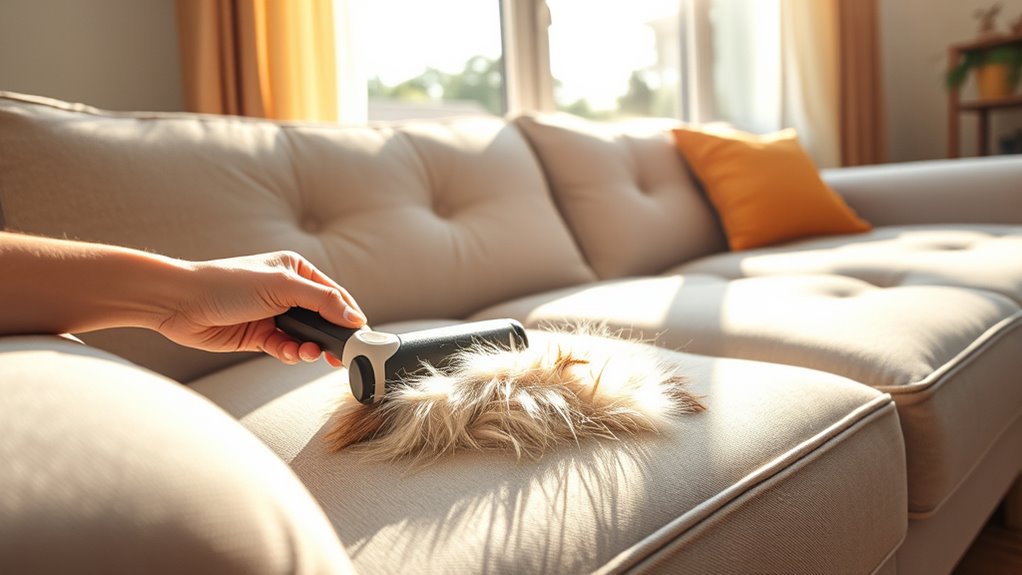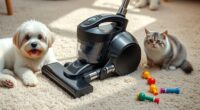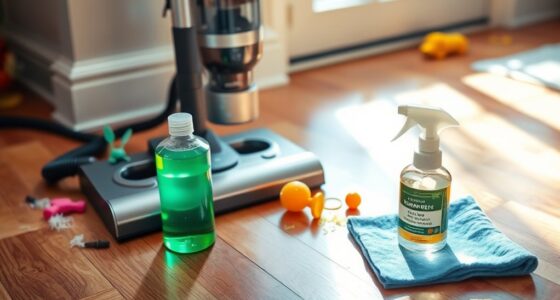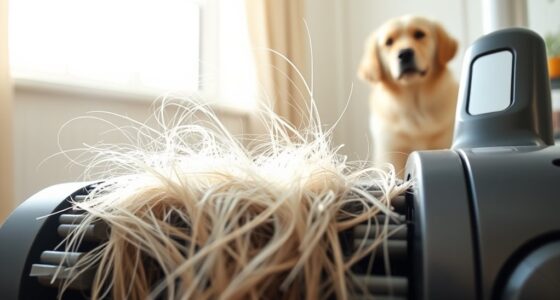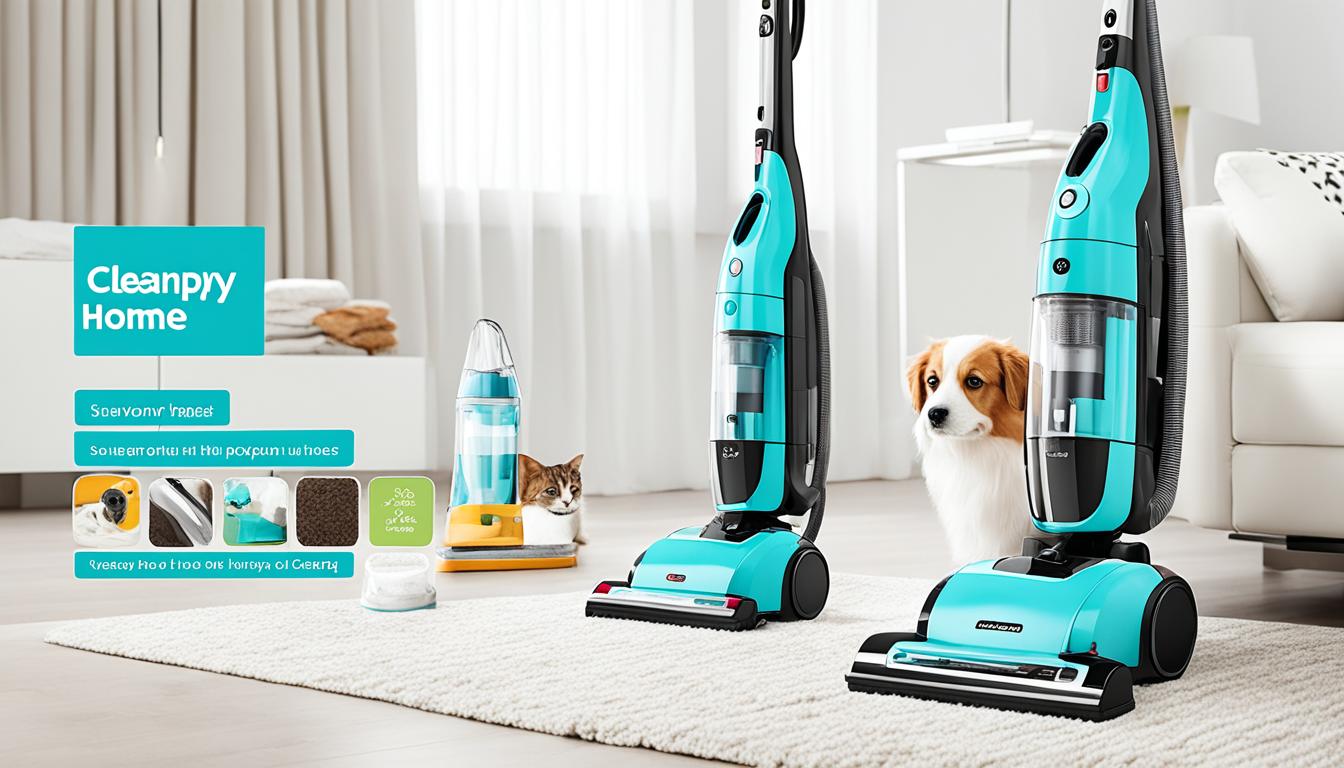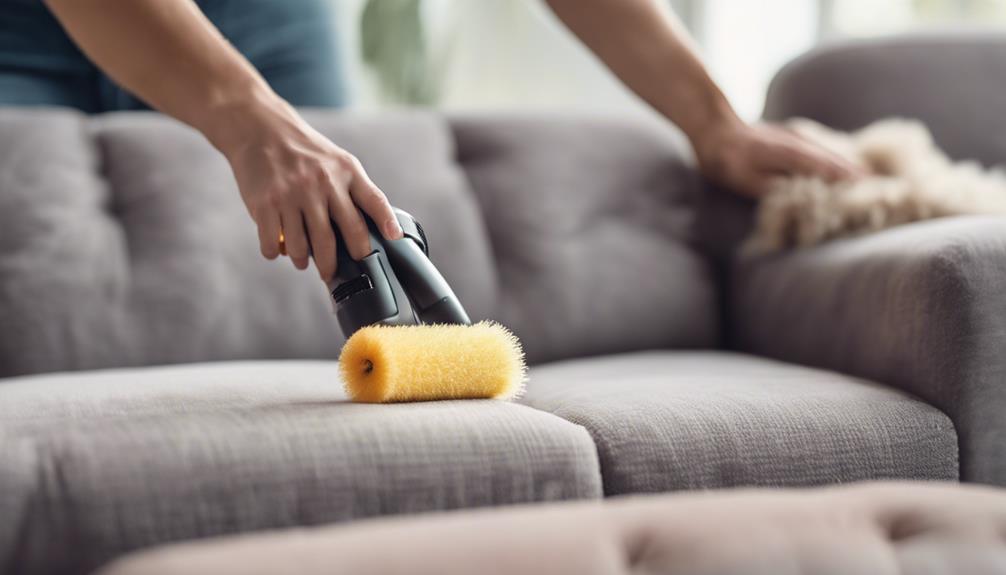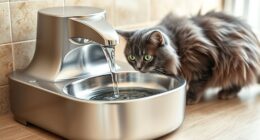Before tackling pet hair cleanup again, assess your pet’s shedding habits and gather the right tools, like lint rollers, rubber gloves, or specialized vacuums. Clear your environment of clutter and prepare your cleaning space. Focus on removing loose hair from furniture and floors using suitable techniques for different surfaces. Identifying high-traffic zones helps target problem areas. Stay consistent with your routine, and you’ll discover smarter ways to keep your home pet-hair free.
Key Takeaways
- Clear clutter from surfaces and floors to make pet hair removal easier and more effective.
- Use the appropriate tools like lint rollers, rubber gloves, or pet-specific vacuums before touching or cleaning surfaces.
- Open windows or turn on vents to improve airflow and reduce hair circulation in the environment.
- Identify high-traffic and pet-lounging areas to target cleaning efforts efficiently.
- Ensure your pet is well-groomed and brushed regularly to minimize loose hair before cleaning.
Assess Your Pet’s Shedding Patterns
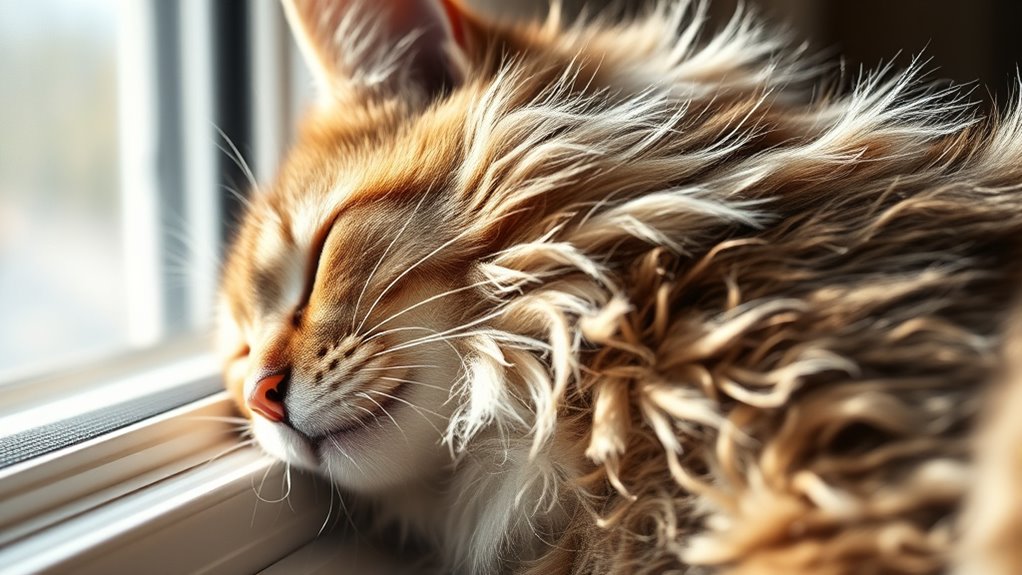
Understanding your pet’s shedding patterns is essential for effective hair cleaning. You need to observe how often your pet sheds and which areas are most affected. Pay attention to the pet hair color—darker fur may be more visible on lighter furniture fabric, while lighter fur shows up more on darker surfaces. This knowledge helps you identify the best cleaning approach and prioritize areas that accumulate hair quickly. Some pets shed seasonally, while others shed year-round, so tracking these trends allows you to plan your cleaning schedule better. Noticing the specific furniture fabric your pet prefers can also guide you in choosing the right cleaning tools and techniques. Additionally, understanding animal health and nutrition can influence shedding patterns, helping you manage hair loss more effectively. Being aware of these patterns keeps your home cleaner and more comfortable for both you and your furry friend.
Choose the Right Tools for Pet Hair Removal
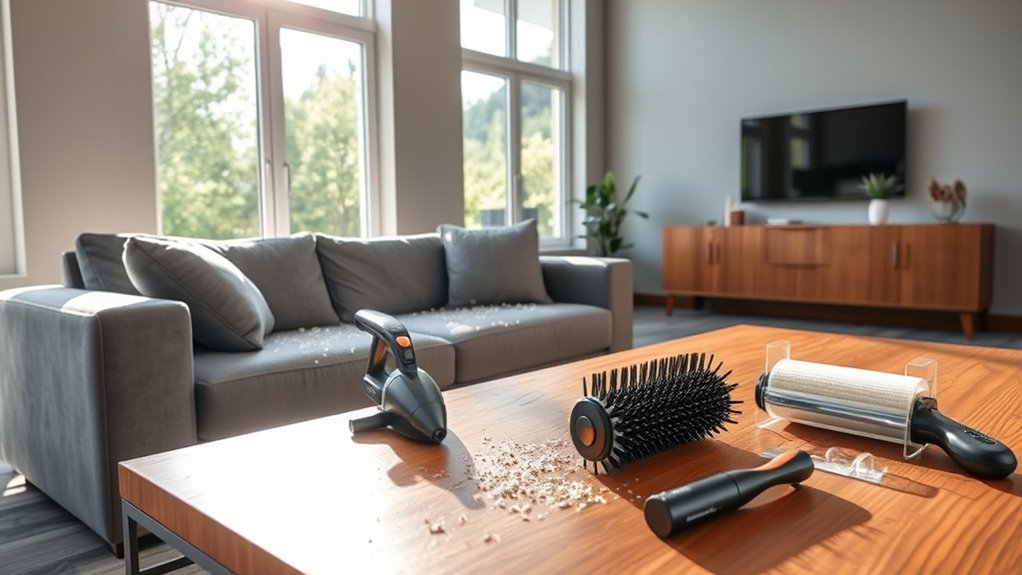
Selecting the right tools is essential for effectively removing pet hair from your home. The right pet hair tools can simplify shedding management and keep your space cleaner. First, consider a rubber gloves or a silicone broom, which excel at gathering hair from fabric and upholstery. Second, a lint roller or adhesive sheets quickly pick up hair from clothing and furniture. Third, a motorized vacuum with specialized pet hair attachments can handle larger areas and stubborn shedding. These tools work together to target different surfaces and hair types, making cleaning more efficient. Additionally, using tools designed for pet hair removal can help prevent damage to delicate surfaces while maximizing cleaning effectiveness. Using the proper pet hair tools not only saves time but also reduces pet hair buildup, keeping your home fresher and more comfortable.
Prepare Your Cleaning Environment
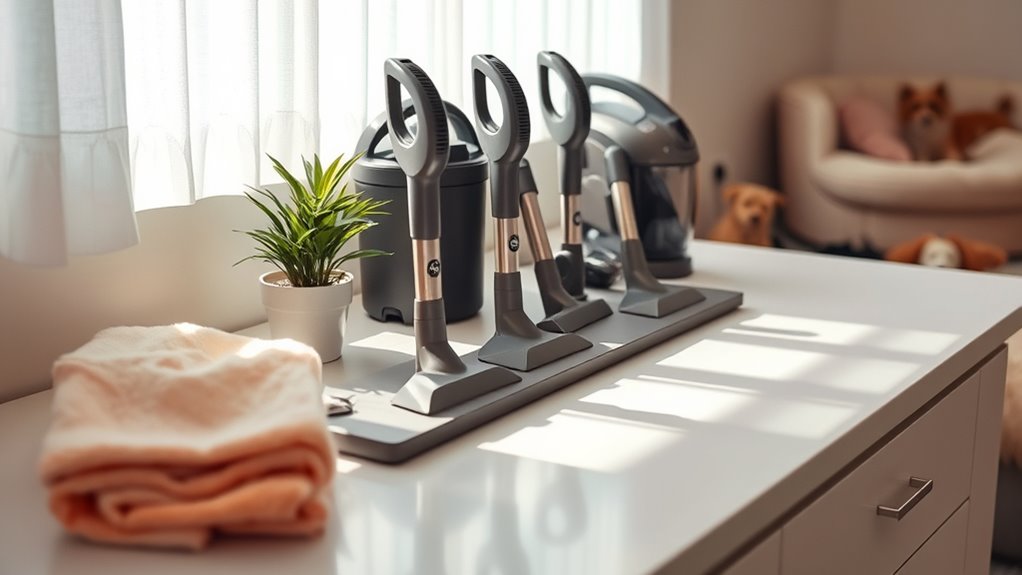
Start by clearing clutter to give yourself space to work efficiently. Open windows or turn on vents to let fresh air in and reduce pet hair circulation. A clean, well-ventilated area makes pet hair removal easier and more effective. Incorporating essential oils for respiratory health, such as eucalyptus or peppermint, can also help improve air quality during the cleaning process.
Clear Clutter First
Before you begin cleaning pet hair, it’s essential to clear away clutter that could get in your way. Clutter can hinder your efforts and reinforce pet hair myths, like believing vacuuming is enough or that pet hair doesn’t stick to certain surfaces. To prepare effectively, focus on:
- Removing unnecessary items from floors and furniture to create a clear workspace.
- Gathering cleaning tools like a vacuum, lint roller, and microfiber cloth for quick access.
- Clearing surfaces where pet hair tends to accumulate, such as cushions and corners.
- Considering the contrast ratio of your cleaning environment, as a higher contrast can help you better see pet hair against various backgrounds.
Clearing clutter not only streamlines your cleaning process but also challenges cleaning myths that suggest less effort is needed. A tidy space makes it easier to see pet hair, ensuring a thorough clean and preventing the misconception that pet hair is impossible to remove.
Ventilate the Area
To effectively remove pet hair, you need to guarantee proper ventilation in your cleaning area. Optimizing airflow allows fresh air to circulate, helping to loosen pet hair and prevent it from settling further. Open windows or use fans to enhance airflow, which aids in odor mitigation by dispersing pet smells. Good ventilation also reduces airborne allergens, making the environment safer and more comfortable. Before you start cleaning, assure the space is well-ventilated to avoid trapping pet hair and odors indoors. Proper airflow not only improves cleaning efficiency but also makes the process more comfortable and less overwhelming. Take a few minutes to ventilate the area thoroughly; it’s a simple step that has a big impact on your pet hair removal success.
Tackle Loose Hair Before Deep Cleaning
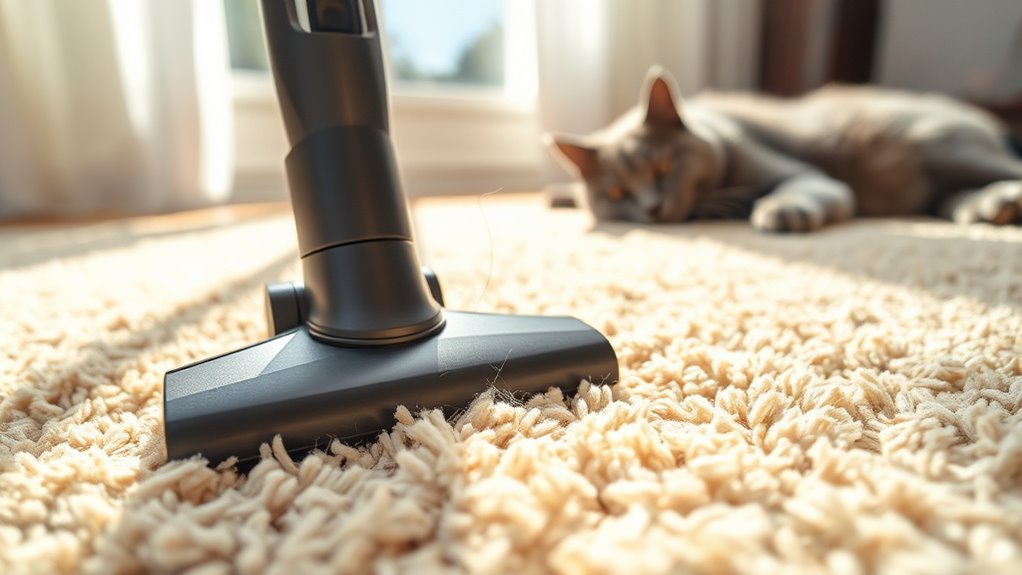
Before you start deep cleaning, remove loose pet hair with a lint roller or vacuum. These tools help lift hair quickly and prevent it from spreading during cleaning. Taking this step guarantees a more effective and thorough clean overall.
Use a Lint Roller
Using a lint roller is an easy and effective way to remove loose pet hair from fabrics and upholstery. It quickly picks up pet hair, making your cleaning process more efficient. To maximize pet hair removal, follow these steps:
- Roll the lint roller firmly over the surface, pressing to lift loose hair from fibers.
- Use multiple sheets if needed, especially on heavily coated areas.
- Focus on seams, cushions, and corners where pet hair tends to accumulate.
This simple tool saves time and effort, preventing pet hair from spreading during deep cleaning. Keep a lint roller handy in your cleaning arsenal to tackle pet hair before it settles further. It’s an essential step in maintaining a fur-free home and making your overall cleaning routine more effective.
Vacuum Regularly
Regular vacuuming is the most effective way to remove loose pet hair from your carpets, rugs, and upholstery before it has a chance to settle deeper into fibers. Consistent vacuuming helps manage pet allergies by reducing airborne hair and dander, improving indoor air quality. It also prevents pet hair from accumulating in hidden storage spots, making deep cleaning easier and more efficient. Use a vacuum with a strong suction and a HEPA filter to trap allergens effectively. Focus on high-traffic areas and furniture where pet hair tends to gather. Regular vacuuming keeps loose hair in check and minimizes pet allergy symptoms, ensuring your space stays cleaner and healthier for everyone. Incorporating Tesla Tuning techniques can also optimize your home’s vacuuming equipment for better performance. Make it a routine to tackle pet hair before it becomes a stubborn problem.
Use the Proper Techniques for Different Surfaces
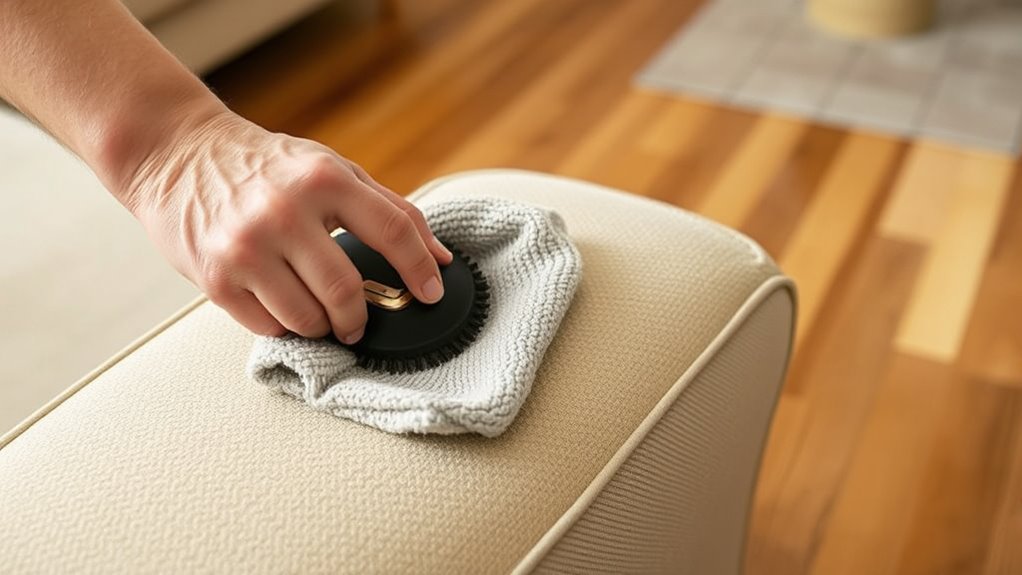
To effectively remove pet hair, you need to adjust your cleaning techniques based on the surface you’re tackling. Surface-specific techniques and material considerations are key. For hard floors, use a microfiber mop or lint roller to pick up hair without spreading it. Soft fabrics like upholstery benefit from a rubber glove or a damp cloth to lift hair easily. Carpets may require a vacuum with strong suction or a brush attachment to dislodge pet hair embedded in fibers. Additionally, tuning modifications for your cleaning tools can improve their efficiency and longevity.
Consider Your Pet’s Grooming Routine

Keeping a regular brushing schedule helps reduce the amount of loose hair around your home. Proper bathing techniques also prevent excess shedding and keep your pet’s coat healthy. By maintaining your pet’s grooming routine, you can make cleaning up pet hair much easier.
Regular Brushing Schedule
Since your pet’s grooming routine directly impacts the amount of loose hair around your home, establishing a consistent brushing schedule is essential. Many pet hair myths persist, but understanding shedding cycles helps you manage hair more effectively. Regular brushing reduces loose hair and minimizes shedding in your living space. To optimize your routine:
- Brush your pet at least 3 times a week to catch shedding cycles early.
- Use the right tools—slicker brushes for dense coats, grooming gloves for short-haired pets.
- Adjust frequency based on seasonal shedding patterns to prevent excess hair buildup.
- Incorporate self watering plant pots into your home decor to help maintain a clean environment by effectively managing moisture and reducing overwatering-related issues.
Consistent brushing not only keeps hair under control but also promotes healthier skin. By sticking to a routine, you’ll stay ahead of pet hair myths and keep your home cleaner.
Proper Bathing Techniques
Regular brushing helps control loose hair and reduces shedding, but proper bathing is equally important for maintaining your pet’s coat health. When performing pet bathing, use lukewarm water and a gentle, pet-specific shampoo to avoid skin irritation. Wet your pet thoroughly, ensuring you reach the skin without over-wetting the fur. Massage the shampoo into the coat, following your pet’s grooming techniques to avoid stress and discomfort. Rinse completely to remove all soap residue, which can cause irritation or itching. Use a towel or blow dryer on a low, cool setting to dry your pet gently. Consistent, proper bathing improves coat condition, reduces shedding, and supports overall hygiene—making grooming techniques more effective and your pet happier. Additionally, integrating proper grooming techniques with advanced AI-powered tools can enhance your pet care routine.
Identify High-Traffic and Hair-Accumulating Areas
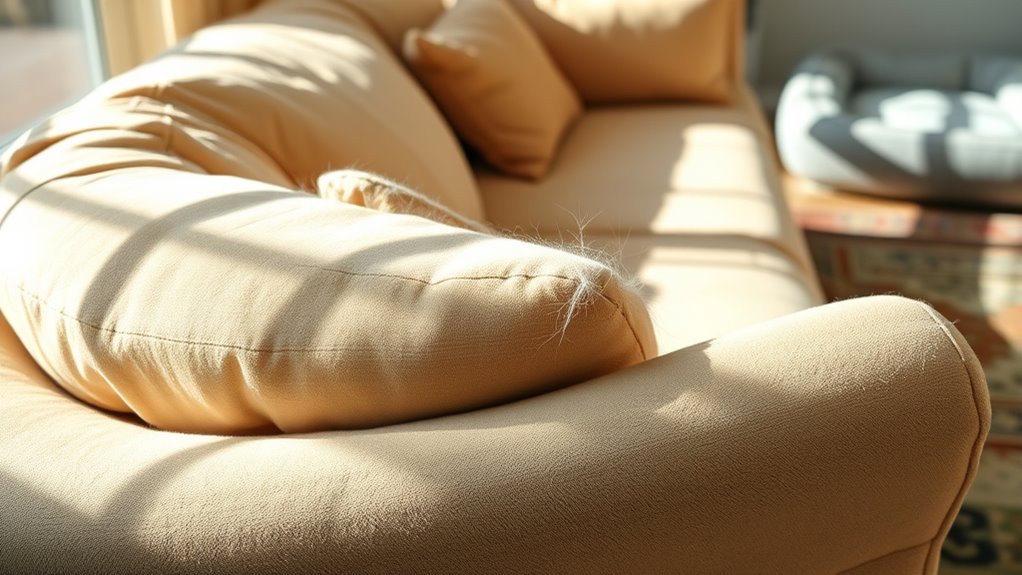
To effectively manage pet hair, you need to identify the areas where your pet spends the most time or tends to shed the most. Start by observing your pet’s habits and noting key spots. Focus on:
- Furniture placement, especially sofas and chairs where your pet lounges frequently.
- Pet activity zones like beds, play areas, or favorite resting spots.
- High-traffic areas, such as hallways or doorways, where pet hair may spread more easily.
- Be aware of symptoms of pet-related health issues that could be exacerbated by excessive pet hair in your environment.
Select Effective Cleaning Products
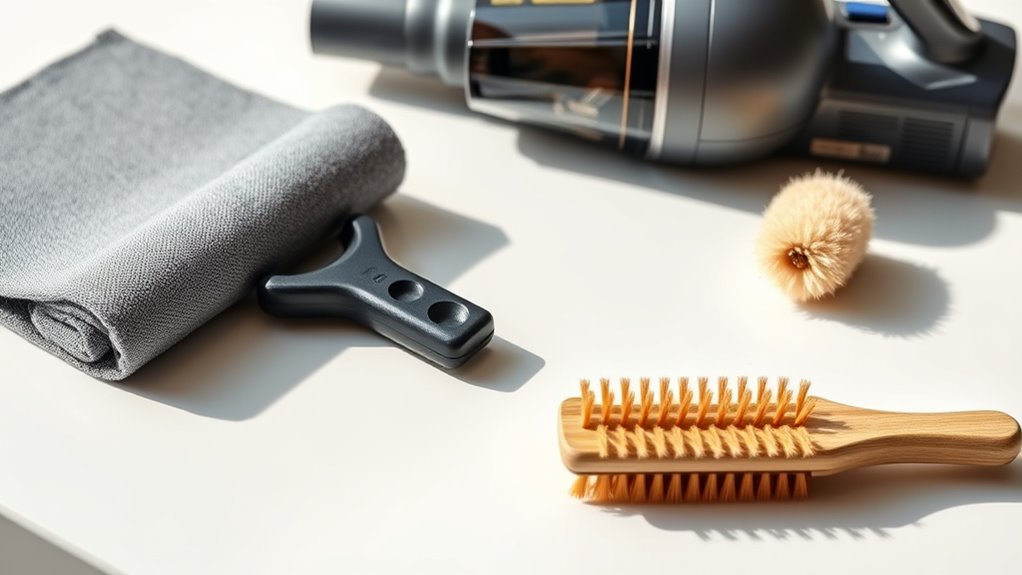
Choosing the right cleaning products can make a big difference in controlling pet hair around your home. To improve pet hair removal, select products known for their cleaning product efficacy. Look for vacuum cleaners with strong suction and specialized attachments designed for pet hair. Use lint rollers or rubber gloves to pick up hair from furniture and clothing easily. For hard surfaces, opt for sprays or wipes formulated to loosen and lift pet hair without spreading it around. Avoid harsh chemicals that may damage surfaces or trigger allergies. Testing different products helps you find what works best for your home. Additionally, selecting gentle cleaning solutions can help prevent surface damage and reduce allergic reactions. By choosing effective cleaning products, you’ll make pet hair removal quicker and more efficient, keeping your space cleaner and more comfortable for everyone.
Schedule Regular Maintenance to Minimize Hair Build-Up
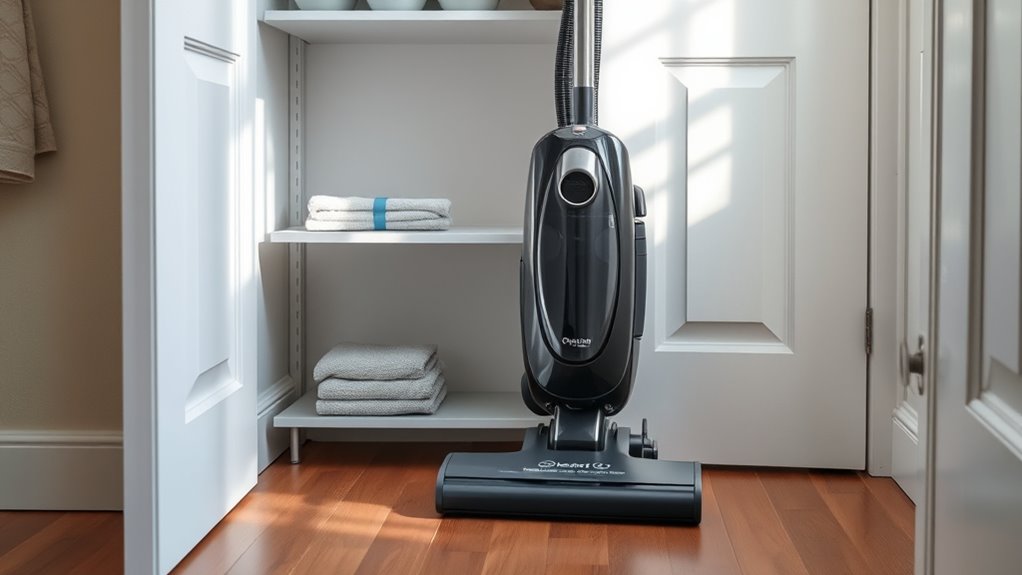
Scheduling consistent maintenance sessions is essential for keeping pet hair under control. Regular upkeep helps manage shedding cycles and improves dander control, making your space healthier. To maximize effectiveness, focus on these steps:
- Vacuum frequently, especially during shedding peaks, to catch loose hair and dander before they settle.
- Schedule professional cleanings for carpets and upholstery to remove embedded pet hair and reduce allergens.
- Maintain your pet’s grooming routine, including brushing and bathing, to lessen shedding and minimize dander release.
Establish a Consistent Cleaning Routine
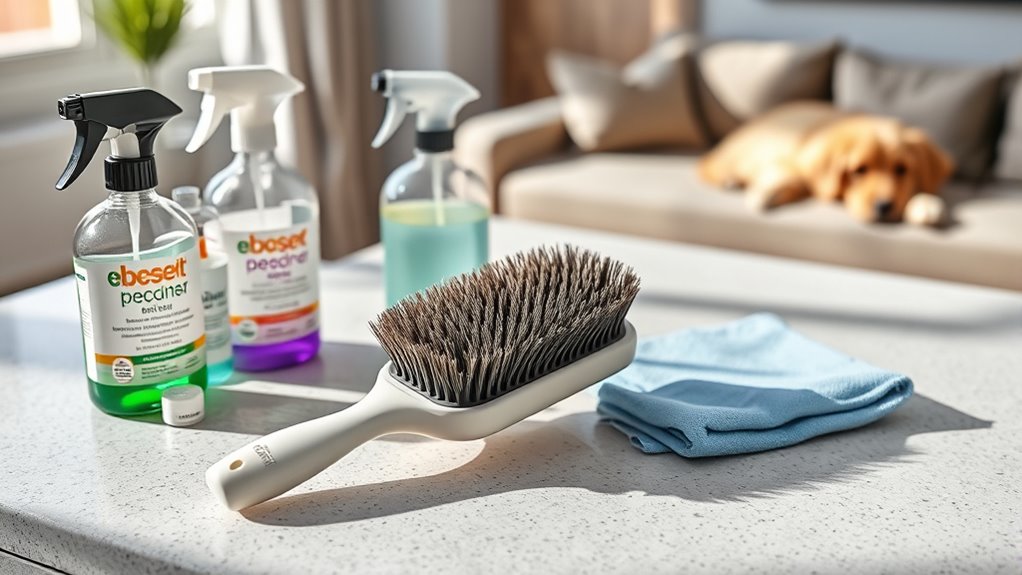
Establishing a consistent cleaning routine is key to effectively managing pet hair in your home. Many pet hair myths suggest that only deep cleaning helps, but regular maintenance prevents hair from accumulating. By sticking to a routine—vacuuming floors, brushing your pet, and wiping surfaces—you reduce hair spread and make cleanup easier. This consistency also plays a crucial role in allergy prevention, as pet hair can trap allergens that worsen symptoms. When you clean regularly, you minimize the amount of hair and dander lingering in your environment. Avoid letting hair pile up, which can make allergy symptoms worse and reinforce false pet hair myths. Making cleaning a habit ensures your home stays pet hair-free, healthier, and more comfortable for everyone. Regular maintenance routines can also help prolong the effectiveness of your cleaning efforts.
Frequently Asked Questions
How Often Should I Vacuum My Home to Control Pet Hair?
You should vacuum your home at least twice a week to control pet hair effectively. Adjust the vacuum frequency based on your pet’s shedding schedule—more often during heavy shedding periods and less when shedding slows down. Regular vacuuming helps prevent pet hair buildup, reduces allergens, and keeps your home cleaner. By staying consistent with your vacuum routine, you’ll manage pet hair better and maintain a fresher, healthier living space.
Are Natural Cleaning Products Better for Pet Hair Removal?
Yes, natural cleaning products can be better for pet hair removal because they often use eco-friendly alternatives and avoid harsh chemicals. These products are safer for your pets and family, reducing chemical safety concerns. Plus, many natural options effectively loosen and lift pet hair without damaging surfaces. Always check labels to make sure they’re truly natural and eco-friendly, making your cleaning routine safer and more sustainable for everyone in your home.
Can Air Purifiers Reduce Pet Hair and Dander Effectively?
Air purifiers can effectively reduce pet hair and dander, especially models with high air purifier effectiveness and specialized pet hair filtration. They catch airborne particles, helping to improve air quality and lessen allergy symptoms. To maximize results, choose a purifier with a HEPA filter designed for pet hair, and run it consistently in your living spaces. Keep filters clean and replace them as recommended to guarantee ongoing pet hair filtration success.
What’s the Best Way to Remove Pet Hair From Upholstered Furniture?
Get your upholstery looking fresh by using a rubber glove for pet hair removal; it’s like hitting two birds with one stone. Simply dampen the glove and run your hand over the furniture to lift hair easily. Follow up with upholstery cleaning to remove any remaining fur and dirt. This quick, effective approach keeps your furniture pet-hair free, making your space look tidy and inviting again.
How Can I Train My Pet to Shed Less Hair?
To train your pet to shed less hair, start with consistent behavior modification by rewarding calm and hairless behaviors. Incorporate regular grooming routines, brushing your pet frequently to remove loose fur before it sheds around your home. Use positive reinforcement to encourage good habits, and be patient as your pet adapts. Over time, these steps help reduce shedding and keep your living space cleaner.
Conclusion
Now that you know these tips, you’ll make pet hair cleaning a breeze. Are you ready to stay ahead of shedding and keep your home spotless? With a little preparation and consistent effort, pet hair won’t control your space anymore. Remember, tackling hair early and using the right tools makes all the difference. So, why not start today and enjoy a cleaner, fresher home for you and your furry friends?
